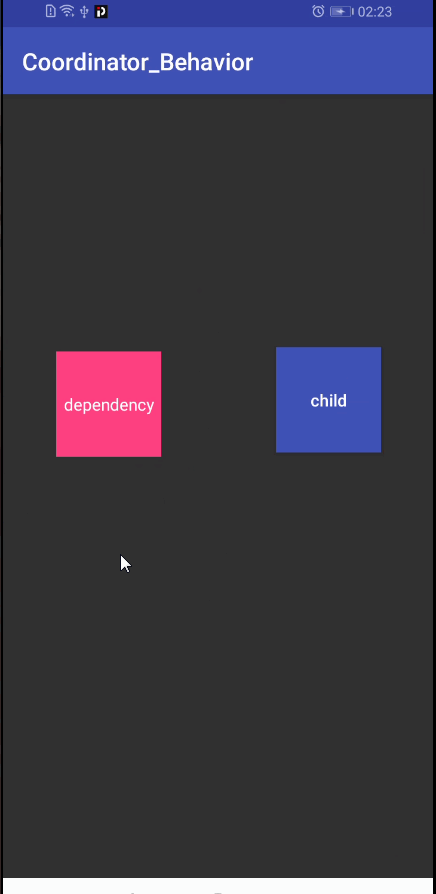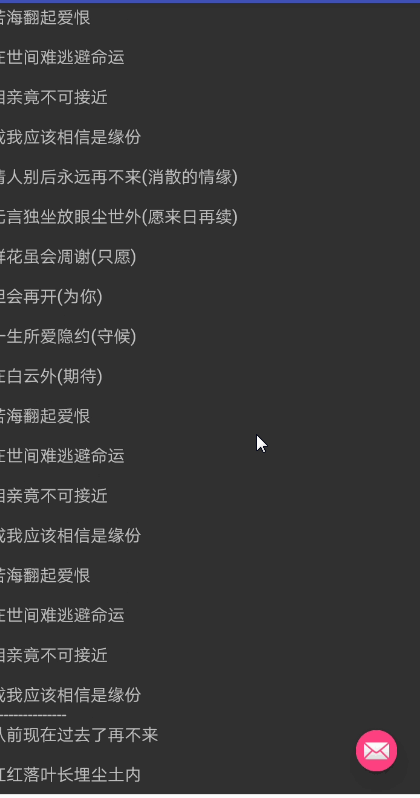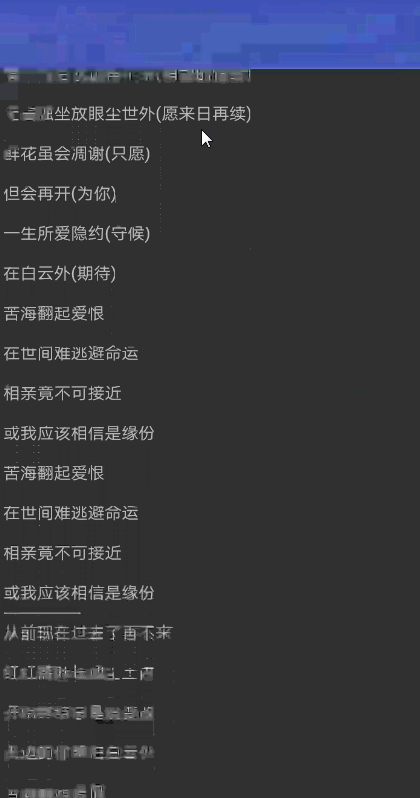协调布局CoordinatorLayout
概况
- CoordinatorLayout中文翻译为协调布局,它可以协调子布局之间交互,当触摸改变孩子View的时候会影响布局从而产生联动效果,产生的根源在于Behavior类
- CoordinatorLayout自己并不控制View,所有的控制权都在Behavior这个类
- 系统里Behavior有FloatingActionButton.Behavior和AppBarLayout.Behavior等等;我们平时用户那些联动都是靠系统定义的Behavior来实现
- 系统里面Behavoir有些实现了复杂的控制功能。但是毕竟有限,我们可以通过自定义的方式来实现自己的Behavior
自定义Behavior
自定义Behavior有两种方式
第一种方式
一个View监听另一个View的状态变化,实现方式如下
1.继承CoordinatorLayout.Behavior类
/**
* 第一种自定义Behavior方式
*/
public class DependencyBehavior extends CoordinatorLayout.Behavior<Button> {
2.重写Behavior两个参数的构造方法
/**
* 这个构造方法必须重载,因为在CoordinatorLayout里利用反射去获取
* Behavior的时候就是拿的这个构造
*/
public DependencyBehavior(Context context, AttributeSet attrs) {
super(context, attrs);
width = context.getResources().getDisplayMetrics().widthPixels;
}
3.重写layoutDependsOn和onDependentViewChanged方法
/**
* 确定依赖关系
*
* @param parent
* @param child 要执行动作的View
* @param dependency child要依赖的View,,,也就是Child要监听的View
* @return 根据逻辑确定依赖关系
*/
@Override
public boolean layoutDependsOn(CoordinatorLayout parent, Button child, View dependency) {
Log.e("Behavior", "----child: " + child.toString());
Log.e("Behavior", "----dependency: " + dependency.toString());
return dependency instanceof DragTextView;
}
/**
* 状态(大小、位置、显示与否等)发生变化时该方法执行
* 在这里我们定义child要执行的具体动作
*
* @param parent
* @param child
* @param dependency
* @return
*/
@Override
public boolean onDependentViewChanged(CoordinatorLayout parent, Button child, View dependency) {
int top = dependency.getTop();
int left = dependency.getLeft();
int x = width - left - child.getWidth();
int y = top;
setPosition(child, x, y);
return true;
}
4.在xml文件中引用app:layout_behavior
<?xml version="1.0" encoding="utf-8"?>
<androidx.coordinatorlayout.widget.CoordinatorLayout xmlns:android="http://schemas.android.com/apk/res/android"
xmlns:app="http://schemas.android.com/apk/res-auto"
android:id="@+id/activity_main"
android:layout_width="match_parent"
android:layout_height="match_parent">
<Button
android:layout_width="88dp"
android:layout_height="88dp"
android:background="@color/colorPrimary"
android:gravity="center"
android:text="child"
android:textAllCaps="false"
android:textColor="@android:color/white"
app:layout_behavior="com.coordinator.behavior.first.DependencyBehavior" />
<com.coordinator.behavior.first.DragTextView
android:layout_width="88dp"
android:layout_height="88dp"
android:background="@color/colorAccent"
android:gravity="center"
android:text="dependency"
android:textAllCaps="false"
android:textColor="@android:color/white" />
</androidx.coordinatorlayout.widget.CoordinatorLayout>
5.运行效果

第二种方式
View监听CoordinatorLayout里的滑动状态,这个要求里面要有滑动的控件,最少要实现了NestedScrollingChild接口,比如RecyclerView,NestScrollView等滑动控件;
1.继承CoordinatorLayout.Behavior类或者系统的Behavior类
/**
* 第二种自定义Behavior方式
*/
public class ScrollBehavior extends CoordinatorLayout.Behavior<FloatingActionButton> {
2.重写Behavior两个参数的构造方法
/**
* 这个构造方法必须重载,因为在CoordinatorLayout里利用反射去获取
* Behavior的时候就是拿的这个构造
*/
public ScrollBehavior(Context context, AttributeSet attrs) {
super(context, attrs);
}
3.至少重写onStartNestedScroll和onNestedScroll方法,当然还有其他也可以重写
/**
* 当子View调用NestedScrollingChild的方法startNestedScroll时,会调用该方法。
* 一定要按照自己的需求返回true,该方法决定了当前控件是否能接收到其内部View(并非是直接子View)滑动时的参数
*
* @param coordinatorLayout
* @param child 这个是要依赖其他滚动View的另一个View,这里是FloatingActionButton
* @param directTargetChild 直接触发嵌套滚动的view的对象
* @param target 触发嵌套滚动的view (在这里如果不涉及多层嵌套的话,target和directTargetChild是相同的)
* @param nestedScrollAxes 嵌套滑动的方向标志
* @return 根据返回值确定我们关心那个方向的滑动(x轴 / y轴),这里我们关心的是y轴方向
*/
@Override
public boolean onStartNestedScroll(CoordinatorLayout coordinatorLayout,
FloatingActionButton child,
View directTargetChild,
View target,
int nestedScrollAxes) {
Log.e("123", "directTargetChild: " + directTargetChild);
Log.e("123", "target: " + target);//在这里directTargetChild和target都是NestedScrollView
return (nestedScrollAxes & ViewCompat.SCROLL_AXIS_VERTICAL) != 0;
}
/**
* 当子View调用dispatchNestedPreScroll时会调用该方法
* 该方法会传入内部View移动的dx,dy,如果你需要消耗一定的dx,dy,就会通过最后一个参数consumed
* 进行指定。例如我要消耗一半的dy,就可以写consumed[1]=dy/2
* dx表示本次滚动x方向产生的总距离
*
* @param coordinatorLayout
* @param child 此处是FloatingActionButton
* @param target 同上
* @param dxConsumed target已经消费的x方向的距离
* @param dyConsumed target已经消费的x方向的距离
* @param dxUnconsumed x方向剩下的滑动距离
* @param dyUnconsumed y方向剩下的滑动距离
*/
@Override
public void onNestedScroll(CoordinatorLayout coordinatorLayout,
FloatingActionButton child,
View target,
int dxConsumed,
int dyConsumed,
int dxUnconsumed,
int dyUnconsumed) {
//Log.e("234", "===============dxConsumed: " + dxConsumed);
Log.e("234", "===============dyConsumed: " + dyConsumed);
//Log.e("234","===============dxUnconsumed: "+dxUnconsumed);
Log.e("234", "===============dyUnconsumed: " + dyUnconsumed);
if (((dyConsumed > 0 && dyUnconsumed == 0)
|| (dyConsumed == 0 && dyUnconsumed > 0))
) {
//上滑隐藏
child.animate()
.scaleY(0).scaleX(0)
.setDuration(200)
.start();
} else if (((dyConsumed < 0 && dyUnconsumed == 0)
|| (dyConsumed == 0 && dyUnconsumed < 0))
) {
//下滑显示
child.animate()
.scaleY(1).scaleX(1)
.setDuration(200)
.start();
}
}
4.在xml文件中引用app:layout_behavior
<?xml version="1.0" encoding="utf-8"?>
<androidx.coordinatorlayout.widget.CoordinatorLayout xmlns:android="http://schemas.android.com/apk/res/android"
xmlns:app="http://schemas.android.com/apk/res-auto"
android:layout_width="match_parent"
android:layout_height="match_parent"
android:orientation="vertical">
<androidx.core.widget.NestedScrollView
android:layout_width="match_parent"
android:layout_height="wrap_content">
<TextView
android:layout_width="match_parent"
android:layout_height="wrap_content"
android:text="@string/text" />
</androidx.core.widget.NestedScrollView>
<com.google.android.material.floatingactionbutton.FloatingActionButton
android:id="@+id/fab"
android:layout_width="wrap_content"
android:layout_height="wrap_content"
android:layout_gravity="end|bottom"
android:layout_margin="16dp"
android:src="@android:drawable/ic_dialog_email"
app:backgroundTint="@color/colorAccent"
app:elevation="8dp"
app:fabSize="mini"
app:layout_behavior="com.coordinator.behavior.second.ScrollBehavior"
app:pressedTranslationZ="16dp"
app:rippleColor="@color/colorPrimary" />
</androidx.coordinatorlayout.widget.CoordinatorLayout>
5.运行效果

原理
1.子View如何拿到Behavior
比如下面的xml文件中是怎么拿到Behavior的呢?

CoordinatorLayout有一个过程是要添加孩子View,我们就先从哪里入手吧,

这里的LayoutParam肯定是CoordinatorLayout.LayoutParam生成的吧;

这里明显Behavior就是在LayoutParams里面解析得来的,就是解析的app:layout_behavior属性;

2.Behavior是怎么接到事件的

上面只是代码一种特殊的情况,其实在事件传递中,你会发现,所有出现Behavior的地方Behavior都会去接管处理!这里不想云里雾里一点点分析,那样容易只见树木不见森林。你就从
dispatchTouchEvent,
onInterception,
onTouchEvent,
这些事件往代码里面分析,就能够看到代码段;
Behavior b = lp.getBehavior()
你懂得,就是把所有的事件处理都转给它;
仿效系统协调布局实现方式
1.实现自己的协调布局BehaviorCoordinatorLayout
public class BehaviorCoordinatorLayout extends RelativeLayout implements NestedScrollingParent,
ViewTreeObserver.OnGlobalLayoutListener {
public BehaviorCoordinatorLayout(Context context, AttributeSet attrs) {
super(context, attrs);
getViewTreeObserver().addOnGlobalLayoutListener(this);
}
@Override
public boolean onStartNestedScroll(View child, View target, int nestedScrollAxes) {
return true;
}
@Override
public void onNestedScroll(View target, int dxConsumed, int dyConsumed, int dxUnconsumed, int dyUnconsumed) {
int count = getChildCount();
for (int i = 0; i < count; i++) {
View v = getChildAt(i);
LP lp = (LP) v.getLayoutParams();
BeHavior mBehavior = lp.mBehavior;
if (mBehavior != null) {
mBehavior.onNestedScroll(this, v, target, dxConsumed, dyConsumed, dxUnconsumed, dyUnconsumed);
}
}
}
@Override
public void onGlobalLayout() {
int count = getChildCount();
for (int i = 0; i < count; i++) {
View v = getChildAt(i);
LP lp = (LP) v.getLayoutParams();
BeHavior mBehavior = lp.mBehavior;
if (mBehavior != null) {
mBehavior.onLayoutChild(this, v, 0);
}
}
}
@Override
public LayoutParams generateLayoutParams(AttributeSet attrs) {
return new LP(getContext(), attrs);
}
2.实现自己的LayoutParams
@Override
public LayoutParams generateLayoutParams(AttributeSet attrs) {
return new LP(getContext(), attrs);
}
public static class LP extends RelativeLayout.LayoutParams {
BeHavior mBehavior;
public LP(Context c, AttributeSet attrs) {
super(c, attrs);
TypedArray ta = c.obtainStyledAttributes(attrs, R.styleable.BehaviorCoordinatorLayout_Layout);
if (ta.hasValue(R.styleable.BehaviorCoordinatorLayout_Layout_custom_layout_behavior)) {
String clStr = ta.getString(R.styleable.BehaviorCoordinatorLayout_Layout_custom_layout_behavior);
Log.e("tag", clStr);
mBehavior = parseBehavior(c, attrs, clStr);
Log.e("tag", (mBehavior == null) + " ");
}
ta.recycle();
}
public BeHavior parseBehavior(Context context, AttributeSet attrs, String name) {
try {
Class<?> clazz = Class.forName(name, false, context.getClassLoader());
Constructor c = clazz.getConstructor(Context.class, AttributeSet.class);
c.setAccessible(true);
return (BeHavior) c.newInstance(context, attrs);
} catch (Exception e) {
e.printStackTrace();
return null;
}
}
}
3.实现自己的Behavior类
public class BeHavior<V extends View> {
public BeHavior(Context context, AttributeSet attrs) {
}
public boolean onLayoutChild(BehaviorCoordinatorLayout parent, V child,
int layoutDirection) {
return false;
}
public void onNestedScroll(BehaviorCoordinatorLayout coordinatorLayout, V child,
View target, int dxConsumed, int dyConsumed, int dxUnconsumed,
int dyUnconsumed) {
}
}
4.实现自己的Behavior子类
ublic class ImageViewBehavior extends BeHavior<ImageView> {
public ImageViewBehavior(Context context, AttributeSet attrs) {
super(context, attrs);
}
int maxHeight = 400;
int originHeight = 0;
@Override
public boolean onLayoutChild(BehaviorCoordinatorLayout parent, ImageView child, int layoutDirection) {
if (originHeight == 0) {
originHeight = child.getHeight();
}
return super.onLayoutChild(parent, child, layoutDirection);
}
@Override
public void onNestedScroll(BehaviorCoordinatorLayout coordinatorLayout, ImageView child,
View scrollview, int dxConsumed, int dyConsumed,
int dxUnconsumed, int dyUnconsumed) {
if (scrollview.getScrollY() > 0) {
BehaviorCoordinatorLayout.LP lp = (BehaviorCoordinatorLayout.LP) child.getLayoutParams();
lp.height = lp.height - Math.abs(dyConsumed);
if (lp.height <= originHeight) {
lp.height = originHeight;
}
child.setLayoutParams(lp);
} else if (scrollview.getScrollY() == 0) {
BehaviorCoordinatorLayout.LP lp = (BehaviorCoordinatorLayout.LP) child.getLayoutParams();
lp.height = lp.height + Math.abs(dyUnconsumed);
if (lp.height >= maxHeight) {
lp.height = maxHeight;
}
child.setLayoutParams(lp);
}
}
}
public class ToolbarBehavior extends BeHavior<Toolbar> {
public ToolbarBehavior(Context context, AttributeSet attrs) {
super(context, attrs);
}
int maxHeight = 400;
@Override
public void onNestedScroll(BehaviorCoordinatorLayout coordinatorLayout, Toolbar child, View scrollView,
int dxConsumed, int dyConsumed,
int dxUnconsumed, int dyUnconsumed) {
if (scrollView.getScrollY() <= maxHeight) {
child.setAlpha(scrollView.getScrollY() * 1.0f / maxHeight);
} else if (scrollView.getScrollY() == 0) {
child.setAlpha(0);
}
}
}
5.xml布局中引用
<?xml version="1.0" encoding="utf-8"?>
<com.coordinator.behavior.custom.BehaviorCoordinatorLayout xmlns:android="http://schemas.android.com/apk/res/android"
xmlns:app="http://schemas.android.com/apk/res-auto"
android:layout_width="match_parent"
android:layout_height="match_parent">
<ImageView
android:id="@+id/img"
android:layout_width="match_parent"
android:layout_height="50dp"
android:adjustViewBounds="true"
android:scaleType="fitXY"
android:contentDescription="@string/app_name"
android:src="@mipmap/london"
app:custom_layout_behavior="com.coordinator.behavior.custom.ImageViewBehavior" />
<androidx.core.widget.NestedScrollView
android:layout_width="match_parent"
android:layout_height="wrap_content"
android:layout_below="@id/img">
<TextView
android:layout_width="match_parent"
android:layout_height="wrap_content"
android:text="@string/text" />
</androidx.core.widget.NestedScrollView>
<androidx.appcompat.widget.Toolbar
android:id="@+id/toolbar"
android:layout_width="match_parent"
android:layout_height="50dp"
android:background="@color/colorPrimary"
app:custom_layout_behavior="com.coordinator.behavior.custom.ToolbarBehavior" />
</com.coordinator.behavior.custom.BehaviorCoordinatorLayout>
6.运行效果
